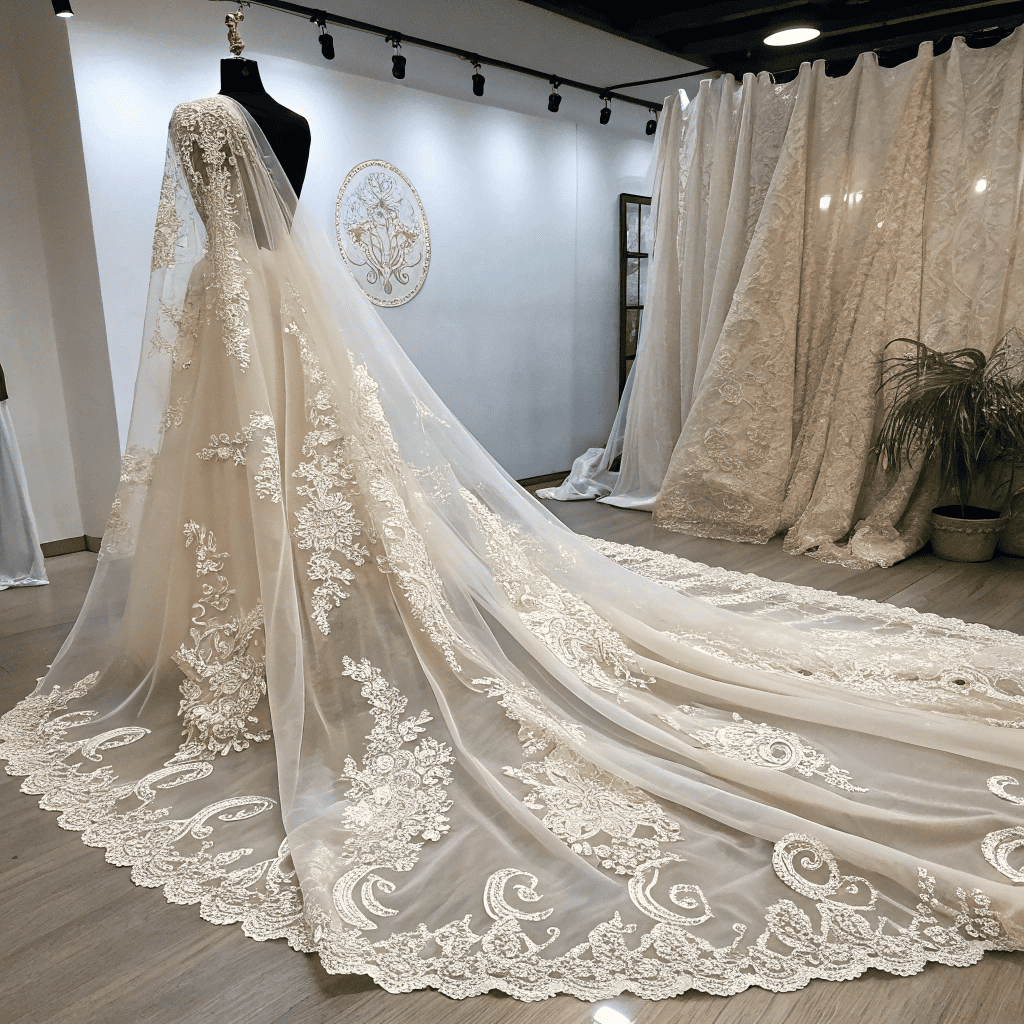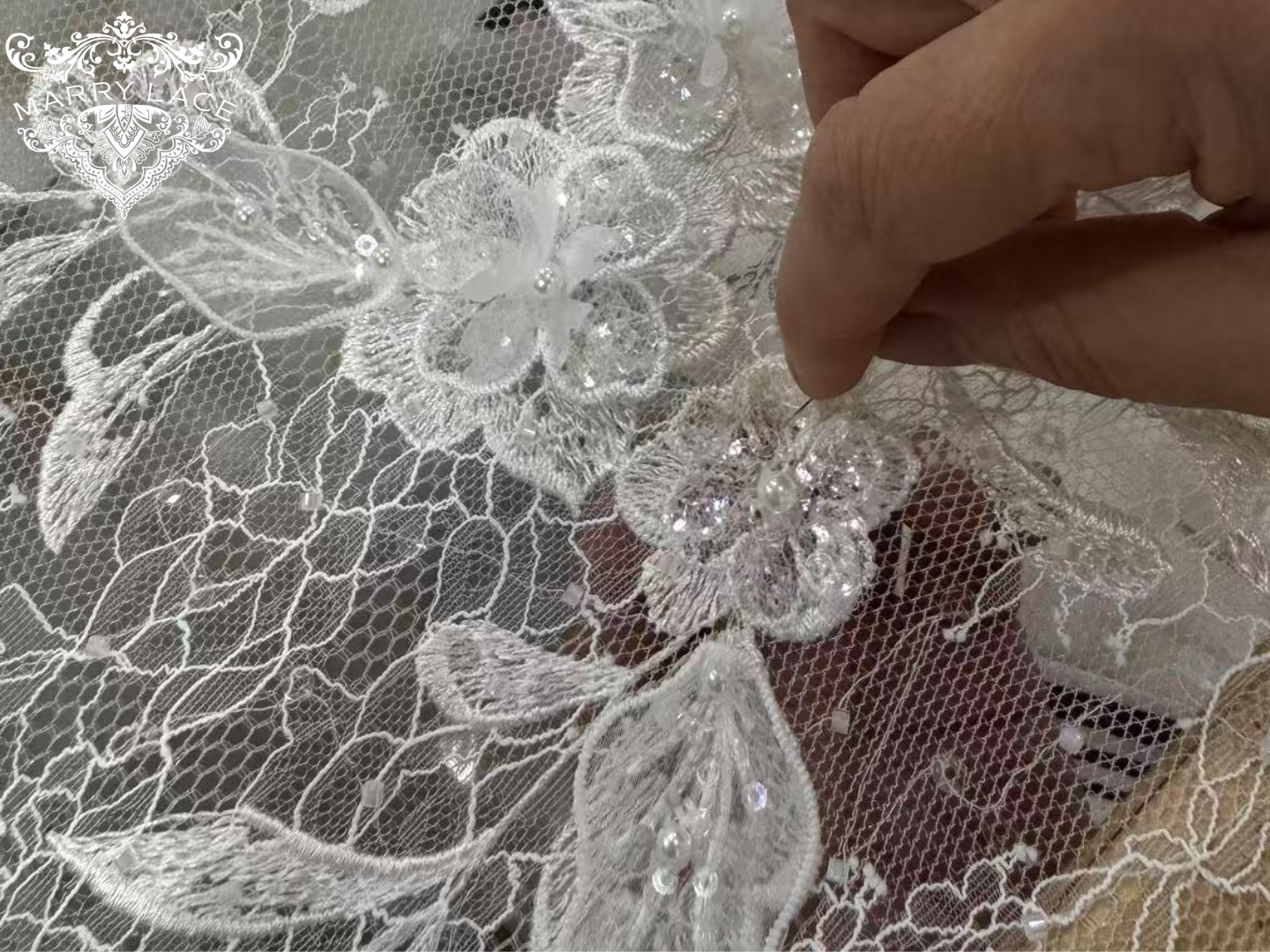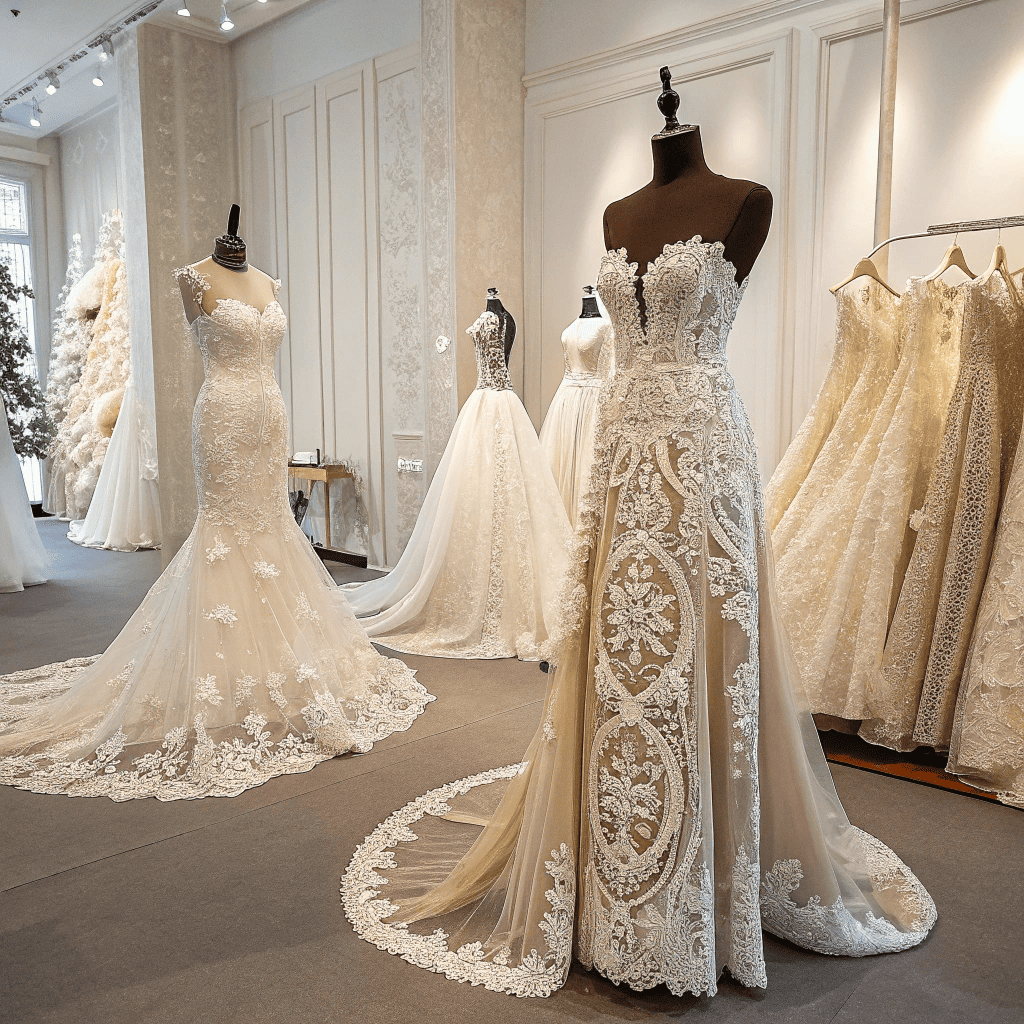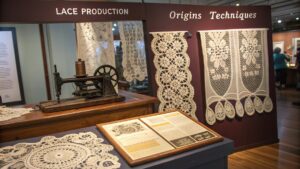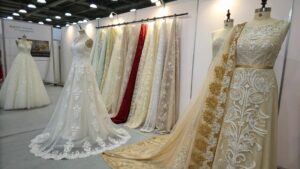Your bridal collection needs that special touch. Finding the perfect lace can make or break your next wedding dress design.
Modern bridal lace combines traditional craftsmanship with contemporary innovation through advanced manufacturing techniques, sustainable materials, and customizable design options. Today’s designers access everything from heritage needle lace to cutting-edge 3D embellished fabrics for creating memorable wedding gowns.
I’ve worked with countless bridal designers who struggled to find lace that matched their vision. The industry has evolved dramatically, offering more options than ever before for creating stunning wedding gowns.
What Are the Latest Trends in Bridal Lace Fabric Design?
Contemporary bridal fashion demands fresh approaches to traditional materials. Modern brides seek unique textures and innovative design elements beyond classic patterns.
Current trends favor 3D floral embellishments, sustainable fiber combinations, and mixed-media lace incorporating beads, sequins, and metallic threads. Designers increasingly choose versatile fabrics that work across different dress silhouettes and style preferences.
The shift toward dimensional textures1 represents the biggest change I’ve observed in recent years. Traditional flat lace patterns no longer satisfy today’s design requirements. MarryLace’s 3D floral embellishment collection demonstrates how manufacturers respond to this demand with innovative construction techniques.
As Sewport explains in their comprehensive fabric analysis, lace has evolved from simple openwork patterns to complex multi-layered constructions. Modern production methods allow manufacturers to create intricate designs that were impossible with traditional handmade techniques.
Color palettes have expanded beyond traditional ivory and white options. Blush tones, champagne shades, and even bold colored laces appear frequently in contemporary bridal collections. This trend reflects broader changes in wedding fashion toward personalization and individual expression.
| Trend Category | Specific Elements | Market Demand | Technical Requirements |
|---|---|---|---|
| 3D Textures | Raised floral motifs | High growth | Advanced machinery |
| Sustainable Options | Organic cotton, recycled fibers | Increasing | Certified suppliers |
| Color Variations | Blush, champagne, pastels | Steady demand | Precise dye matching |
| Mixed Media | Beads, sequins, metallic | Premium market | Specialized application |
Sustainability concerns influence material selection significantly. Organic cotton and responsibly sourced silk gain popularity as environmentally conscious couples seek eco-friendly options. I work with suppliers who provide certifications for their sustainable practices.
Technology integration creates new possibilities for lace design. Computer-controlled embroidery machines produce intricate patterns with consistent quality across large production runs. This technological advancement makes complex designs accessible to more designers while maintaining quality standards.
Customization capabilities satisfy the growing demand for unique bridal pieces. MarryLace’s custom color development services allow designers to create signature looks that differentiate their collections in competitive markets.
Which Lace Manufacturing Techniques Produce the Best Bridal Fabrics?
Different production methods create distinct fabric characteristics that suit various design applications. Understanding these techniques helps designers select appropriate materials for specific projects.
Needle lace and bobbin lace techniques produce the highest quality bridal fabrics, while modern chemical lace and machine embroidery offer cost-effective alternatives with consistent results. Each method creates unique texture and durability characteristics.
Needle lace2 remains the gold standard for luxury bridal applications. According to Sewport’s detailed analysis, this technique produces "exquisitely beautiful" results that justify the time-intensive production process. However, modern machinery can approximate needle lace quality with reasonable fidelity while reducing costs significantly.
I’ve observed that many designers misunderstand the relationship between production method and final quality. Machine-made lace doesn’t automatically mean inferior quality when produced with proper equipment and skilled operators. MarryLace’s manufacturing capabilities demonstrate how modern facilities combine traditional craftsmanship with advanced technology.
Bobbin lace3 techniques work exceptionally well for creating consistent patterns across large fabric widths. This method suits designers who need substantial yardage for full-skirt wedding gowns or extensive overlay applications. The automated bobbin process maintains pattern integrity while enabling volume production.
Chemical lace production4 offers unique advantages for certain design applications. While Sewport notes environmental concerns with traditional chemical methods, newer water-based and heat-based removal techniques address these issues while maintaining production efficiency.
| Production Method | Quality Level | Cost Factor | Best Applications |
|---|---|---|---|
| Hand needle lace | Premium | High | Couture details |
| Machine needle lace | High | Medium-high | Luxury ready-to-wear |
| Bobbin lace3 | High | Medium | Volume production |
| Chemical lace | Good | Low-medium | Budget collections |
Quality control5 becomes critical regardless of production method. Professional manufacturers implement multiple inspection stages to ensure consistency. I always request samples that demonstrate actual production quality rather than relying on marketing materials alone.
Lead times vary dramatically between production methods. Hand needle lace requires months of advance planning, while machine production can accommodate shorter timelines. Understanding these limitations helps designers plan collection development and delivery schedules effectively.
The choice between production methods often depends on target market positioning. Luxury bridal collection pieces justify premium production costs, while contemporary lines require more cost-effective approaches that still deliver acceptable quality levels.
How Do You Select the Right Lace Fabric for Different Dress Styles?
Matching lace characteristics to dress silhouettes requires understanding both fabric properties and garment construction requirements. Poor fabric selection can compromise the entire design concept.
Consider fabric weight, drape characteristics, stretch properties, and pattern scale when selecting lace for specific dress styles. A-line gowns accommodate various lace weights, while fitted styles require stretch fabrics that move with the wearer.
Fabric weight affects both appearance and wearability significantly. According to Sewport’s fabric analysis, lace varies dramatically in complexity and structure, creating different weight categories suitable for specific applications. Heavy beaded lace collection fabrics work beautifully for structured bodices but can overwhelm flowing skirt designs.
Ball gown silhouettes offer the most flexibility for lace selection. Their structured construction supports heavier fabrics while full skirts accommodate extensive lace coverage without overwhelming the design. I frequently specify dramatic lace combinations for these statement pieces.
Mermaid and trumpet styles present unique challenges for lace selection. These form-fitting silhouettes require fabrics with appropriate stretch characteristics to maintain comfort and fit. Non-stretch laces can create pulling and discomfort in these styles, making fabric selection6 critical for wearability.
Sheath and column dresses demand the most precise fabric selection6. Any construction imperfections show clearly on these clean-lined designs. The lace must integrate perfectly with the dress’s minimalist aesthetic while providing appropriate support and coverage.
| Dress Style | Ideal Lace Weight | Stretch Required | Pattern Considerations |
|---|---|---|---|
| Ball gown | Medium to heavy | No | Large-scale patterns work well |
| A-line | Light to medium | Minimal | Versatile pattern options |
| Mermaid | Light with stretch | Essential | Follow body contours |
| Sheath | Lightweight | Some preferred | Subtle patterns best |
Pattern scale impacts visual proportions dramatically. Large-scale patterns can overwhelm petite brides, while tiny patterns may disappear on dramatic ball gowns. I always consider the bride’s physical proportions when recommending lace patterns7 to designers.
Color coordination becomes complex when combining multiple lace types or adding lace to existing fabrics. MarryLace’s design process includes color matching services8 that ensure perfect coordination across different fabric types and production runs.
Structural support requirements change with lace selection. Heavy embellished laces may require additional internal support to prevent sagging or distortion over time. Understanding these requirements during the design phase prevents fitting issues later in the construction process.
What Quality Standards Should Designers Expect from Bridal Lace Suppliers?
Professional lace suppliers must meet stringent quality requirements to support successful bridal collections. Understanding these standards helps designers evaluate potential suppliers effectively.
Expect consistent dye lots, dimensional stability, colorfastness testing, and detailed quality documentation. Professional suppliers provide samples that accurately represent production quality and maintain strict quality control throughout manufacturing processes.
Dye lot consistency9 represents one of the most critical quality factors for bridal applications. Wedding dresses often require multiple fabric cuts from different production runs, making color matching essential. Sewport emphasizes that quality control varies significantly between manufacturers, making supplier selection crucial.
I’ve learned to demand comprehensive quality documentation from all suppliers. This includes colorfastness test results10, dimensional stability measurements, and fiber content verification. MarryLace’s wholesale lace fabric sourcing includes detailed specifications that help designers understand exactly what they’re purchasing.
Sample accuracy becomes critical for bridal applications where final products must match approved designs precisely. Professional suppliers provide production samples that accurately represent bulk manufacturing quality rather than handmade samples that can’t be replicated in volume production.
Environmental testing11 ensures lace performs properly in various conditions. This includes humidity resistance, color stability under UV exposure, and performance after cleaning. These factors become crucial for garments that must maintain appearance throughout long wedding days and storage periods.
| Quality Factor | Testing Standard | Acceptable Range | Critical Applications |
|---|---|---|---|
| Colorfastness | Grade 4+ minimum | 4-5 scale rating | Light-colored fabrics |
| Shrinkage | <3% dimensional change | 1-3% typical | Fitted garments |
| Tensile strength | Industry standards | Varies by fiber type | Structural applications |
| Dye lot variation | Visual matching | <1 Delta E | Multi-piece garments |
Communication quality reveals supplier professionalism levels quickly. Established lace fabric suppliers respond promptly to technical questions and provide detailed specifications without lengthy delays. They understand bridal industry requirements and can anticipate potential issues before they arise.
Production capacity verification ensures suppliers can handle order volumes without compromising quality. I verify manufacturing capabilities, equipment specifications, and quality control systems before committing to significant orders. This due diligence prevents delivery delays and quality issues.
Certification and compliance documentation12 becomes increasingly important as environmental and social responsibility concerns grow. Professional suppliers maintain relevant certifications and can provide documentation for clients who require sustainable or ethically sourced materials.
Conclusion
Success with bridal lace requires understanding current trends, production techniques, fabric selection principles, and quality standards for creating exceptional wedding gowns that satisfy today’s sophisticated brides.
-
Explore this link to understand how dimensional textures are revolutionizing design aesthetics and meeting contemporary demands. ↩
-
Explore the unique qualities of needle lace that make it a top choice for luxury bridal applications. ↩
-
Learn about the efficiency and consistency of bobbin lace for large-scale bridal designs. ↩ ↩
-
Discover the advancements in chemical lace production that address environmental concerns. ↩
-
Understand the significance of quality control in ensuring the best outcomes in lace manufacturing. ↩
-
Understanding fabric selection is crucial for achieving the desired look and comfort in dressmaking; explore this resource for insights. ↩ ↩
-
Dive into the world of lace patterns to see how they can transform designs and suit various body types. ↩
-
Learn about color matching services to ensure your fabric choices harmonize beautifully, enhancing your overall design. ↩
-
Understanding dye lot consistency is vital for ensuring color matching in bridal applications, which is crucial for wedding dress quality. ↩
-
Exploring colorfastness test results helps you grasp their significance in maintaining fabric quality and longevity, especially for wedding dresses. ↩
-
Learn about environmental testing to ensure lace and fabrics perform well under various conditions, crucial for bridal wear durability. ↩
-
Discover the importance of certification and compliance documentation for sustainable sourcing, which is increasingly vital in today’s market. ↩
